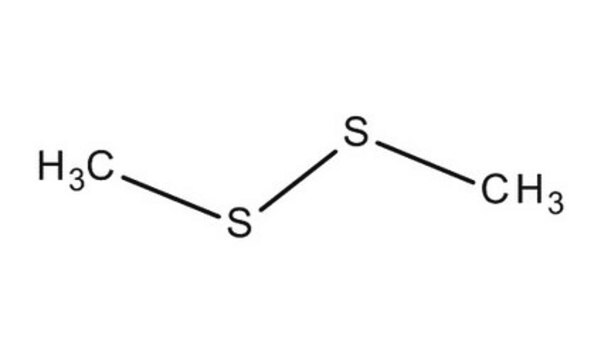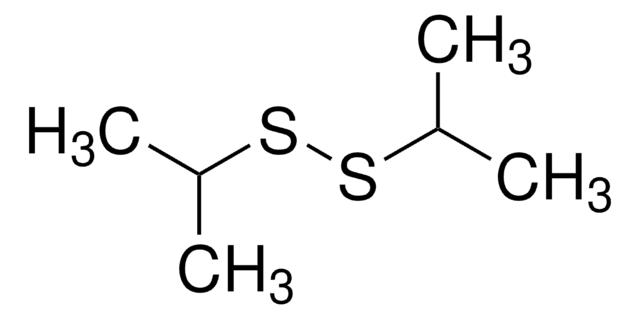W353604
Dimethyl disulfide
≥98%, FG
Sinónimos:
DMDS, Methyl disulfide
About This Item
Productos recomendados
origen biológico
synthetic
Nivel de calidad
grado
FG
Fragrance grade
Halal
Kosher
Agency
follows IFRA guidelines
meets purity specifications of JECFA
cumplimiento norm.
EU Regulation 1223/2009
EU Regulation 1334/2008 & 178/2002
FDA 21 CFR 172.515
densidad de vapor
3.24 (vs air)
presión de vapor
22 mmHg ( 20 °C)
Análisis
≥98%
temp. de autoignición
>572 °F
lim. expl.
16 %
índice de refracción
n20/D 1.525 (lit.)
bp
109 °C (lit.)
mp
−85 °C (lit.)
densidad
1.046 g/mL at 25 °C (lit.)
aplicaciones
flavors and fragrances
Documentación
see Safety & Documentation for available documents
alérgeno alimentario
no known allergens
alérgeno de la fragancia
no known allergens
Organoléptico
cabbage; onion; vegetable; sulfurous
cadena SMILES
CSSC
InChI
1S/C2H6S2/c1-3-4-2/h1-2H3
Clave InChI
WQOXQRCZOLPYPM-UHFFFAOYSA-N
¿Está buscando productos similares? Visita Guía de comparación de productos
Categorías relacionadas
Aplicación
- GC-IMS-Based Volatile Characteristic Analysis of Hypsizygus marmoreus Dried by Different Methods.: Dimethyl disulfide is used to enhance the aroma of some fresh seafood to, this shows that it can be used to optimize flavor (Lai et al., 2024).
Palabra de señalización
Danger
Frases de peligro
Consejos de prudencia
Clasificaciones de peligro
Acute Tox. 3 Inhalation - Acute Tox. 3 Oral - Aquatic Acute 1 - Aquatic Chronic 1 - Eye Irrit. 2 - Flam. Liq. 2 - Skin Sens. 1 - STOT SE 1 Inhalation - STOT SE 3
Órganos de actuación
Central nervous system, Upper respiratory tract
Código de clase de almacenamiento
3 - Flammable liquids
Clase de riesgo para el agua (WGK)
WGK 3
Punto de inflamabilidad (°F)
59.0 °F - closed cup
Punto de inflamabilidad (°C)
15 °C - closed cup
Equipo de protección personal
Eyeshields, Faceshields, Gloves, type ABEK (EN14387) respirator filter
Elija entre una de las versiones más recientes:
¿Ya tiene este producto?
Encuentre la documentación para los productos que ha comprado recientemente en la Biblioteca de documentos.
Los clientes también vieron
Nuestro equipo de científicos tiene experiencia en todas las áreas de investigación: Ciencias de la vida, Ciencia de los materiales, Síntesis química, Cromatografía, Analítica y muchas otras.
Póngase en contacto con el Servicio técnico













